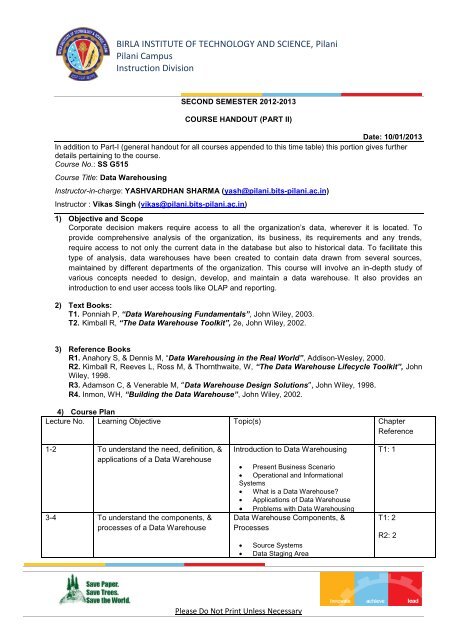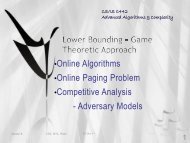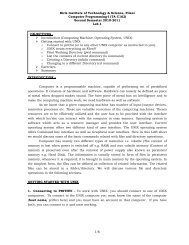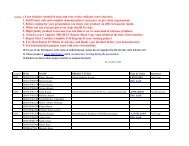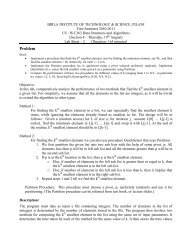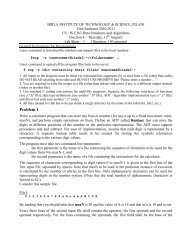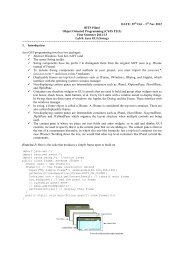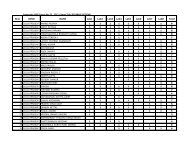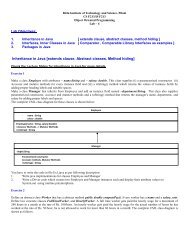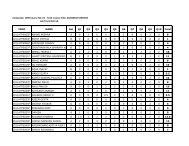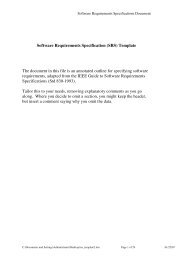Handout - Computer Science & Information Systems. BITS, Pilani
Handout - Computer Science & Information Systems. BITS, Pilani
Handout - Computer Science & Information Systems. BITS, Pilani
Create successful ePaper yourself
Turn your PDF publications into a flip-book with our unique Google optimized e-Paper software.
BIRLA INSTITUTE OF TECHNOLOGY AND SCIENCE, <strong>Pilani</strong><br />
<strong>Pilani</strong> Campus<br />
Instruction Division<br />
SECOND SEMESTER 2012-2013<br />
COURSE HANDOUT (PART II)<br />
Date: 10/01/2013<br />
In addition to Part-I (general handout for all courses appended to this time table) this portion gives further<br />
details pertaining to the course.<br />
Course No.: SS G515<br />
Course Title: Data Warehousing<br />
Instructor-in-charge: YASHVARDHAN SHARMA (yash@pilani.bits-pilani.ac.in)<br />
Instructor : Vikas Singh (vikas@pilani.bits-pilani.ac.in)<br />
1) Objective and Scope<br />
Corporate decision makers require access to all the organization’s data, wherever it is located. To<br />
provide comprehensive analysis of the organization, its business, its requirements and any trends,<br />
require access to not only the current data in the database but also to historical data. To facilitate this<br />
type of analysis, data warehouses have been created to contain data drawn from several sources,<br />
maintained by different departments of the organization. This course will involve an in-depth study of<br />
various concepts needed to design, develop, and maintain a data warehouse. It also provides an<br />
introduction to end user access tools like OLAP and reporting.<br />
2) Text Books:<br />
T1. Ponniah P, “Data Warehousing Fundamentals”, John Wiley, 2003.<br />
T2. Kimball R, “The Data Warehouse Toolkit”, 2e, John Wiley, 2002.<br />
3) Reference Books<br />
R1. Anahory S, & Dennis M, “Data Warehousing in the Real World”, Addison-Wesley, 2000.<br />
R2. Kimball R, Reeves L, Ross M, & Thornthwaite, W, “The Data Warehouse Lifecycle Toolkit”, John<br />
Wiley, 1998.<br />
R3. Adamson C, & Venerable M, “Data Warehouse Design Solutions”, John Wiley, 1998.<br />
R4. Inmon, WH, “Building the Data Warehouse”, John Wiley, 2002.<br />
4) Course Plan<br />
Lecture No. Learning Objective Topic(s) Chapter<br />
Reference<br />
1-2 To understand the need, definition, &<br />
applications of a Data Warehouse<br />
3-4 To understand the components, &<br />
processes of a Data Warehouse<br />
_<br />
Introduction to Data Warehousing<br />
Present Business Scenario<br />
Operational and <strong>Information</strong>al<br />
<strong>Systems</strong><br />
What is a Data Warehouse?<br />
Applications of Data Warehouse<br />
Problems with Data Warehousing<br />
Data Warehouse Components, &<br />
Processes<br />
Source <strong>Systems</strong><br />
Data Staging Area<br />
Please Do Not Print Unless Necessary<br />
T1: 1<br />
T1: 2<br />
R2: 2
BIRLA INSTITUTE OF TECHNOLOGY AND SCIENCE, <strong>Pilani</strong><br />
<strong>Pilani</strong> Campus<br />
Instruction Division<br />
5-6 To understand the Data Warehouse<br />
Architecture<br />
7-8 To learn how to collect business<br />
requirements for a Data Warehouse<br />
9-10 To learn dimensional modeling for<br />
designing database schemas for a<br />
Data Warehouse<br />
11-12 To understand the role of Data Marts<br />
& ODS in Data Warehousing<br />
13-15 To understand advanced<br />
Dimensional Modeling concepts<br />
Presentation Server<br />
Data Marts<br />
Operational Data Store (ODS)<br />
Metadata<br />
<strong>Information</strong> Delivery<br />
Basic Processes of a Data Warehouse<br />
Data Warehouse Architecture<br />
_<br />
Please Do Not Print Unless Necessary<br />
T1: 7<br />
R1: 3 & 4<br />
Collecting Business Requirements T1: 5<br />
Data Warehouse Data Design<br />
Dimensional Modeling Basics<br />
Facts, Dimensions, & Star Schemas<br />
Snowflake & Starflake Schemas<br />
Design Steps<br />
ER modeling vs. Dimensional<br />
modeling<br />
Data Marts & ODS<br />
Architecture<br />
Design<br />
Cost<br />
Advanced Dimensional Modeling<br />
Concepts<br />
Surrogate Keys<br />
Changing Dimensions<br />
Conformed Dimensions<br />
Factless Fact Tables<br />
Minidimensions & Outriggers<br />
Role-playing Dimensions<br />
Multi-valued Dimensions<br />
16-17 To understand the ETL Process Extraction, Transformation, & Loading<br />
(ETL)<br />
Data Extraction<br />
Data Transformation<br />
Data Loading<br />
ETL Data Structures<br />
ETL Tools: Build or Buy?<br />
R2: 4<br />
R3: 15<br />
T1: 10<br />
T2: 1<br />
R1: 5<br />
R2: 5, 6, & 7<br />
R3: 1<br />
T1: 19<br />
R1: 8<br />
R4: 5<br />
T1: 11<br />
+ Class Notes<br />
T1: 12
BIRLA INSTITUTE OF TECHNOLOGY AND SCIENCE, <strong>Pilani</strong><br />
<strong>Pilani</strong> Campus<br />
Instruction Division<br />
18-20 To understand OLAP, its features,<br />
functions, & variations<br />
21-22 To understand role of<br />
Multidimensional Databases in Data<br />
Warehousing<br />
23-24 To understand the new data<br />
warehousing related features of SQL<br />
25-27 To understand efficient cube<br />
computation techniques<br />
_<br />
Online Analytical Processing (OLAP)<br />
Need for OLAP<br />
Features & Functions<br />
ROLAP, MOLAP, HOLAP, & DOLAP<br />
OLAP Implementation<br />
OLAP Tools<br />
Multidimensional Databases (MDDBs) Class Notes<br />
SQL Features for DW<br />
CUBE Operator<br />
Roll-up Operator<br />
Top-N Queries<br />
Window Queries<br />
Cube Computation<br />
Complexity<br />
Optimization Techniques<br />
(ROLAP & MOLAP)<br />
28 Case Study Financial Services-Banks T2: 9<br />
29-32 To understand and implement various<br />
techniques used to reduce the query<br />
response time<br />
Performance Enhancing Techniques<br />
Partitioning<br />
Aggregation<br />
Materialization of Views<br />
Bitmap Indexes<br />
Please Do Not Print Unless Necessary<br />
T1: 15<br />
Class Notes<br />
Class Notes<br />
R3: 3<br />
T1: 11, 18<br />
T2: 16<br />
R1: 6 & 7<br />
R2: 14<br />
33-34 Case Study Academic Data Warehouse: <strong>BITS</strong> <strong>Pilani</strong> T2: 12<br />
35 To understand the role of Metadata Metadata<br />
36 To understand the need for Real<br />
Time Data Warehousing<br />
37-39 Term Paper Presentations by<br />
Students<br />
Role<br />
Design<br />
+ Class Notes<br />
T1: 9<br />
R1: 9<br />
R2: 11<br />
Real-Time Data Warehousing Class Notes<br />
Term Paper Presentations by Students
BIRLA INSTITUTE OF TECHNOLOGY AND SCIENCE, <strong>Pilani</strong><br />
<strong>Pilani</strong> Campus<br />
Instruction Division<br />
40 To expose students to the research<br />
issues in Data Warehsousing<br />
_<br />
Data Warehousing Research Trends Class Notes<br />
5). Evaluation Schedule<br />
Component Duration Weightage(%) Date & Time Remarks<br />
Mid Sem Test 90 Mins. 25 Closed Book<br />
Assignments +<br />
Labs.<br />
30 To be announced<br />
Comprehensive 3 Hours 45 Partly open<br />
6). Assignmentss<br />
A series of study, design, and implementation assignments will be given to the students on a regular<br />
basis. These assignments will immensely help the students in gaining a better understanding of the<br />
subject.<br />
7). Chamber-Consultation Hours<br />
T, Th - 10<br />
8). Notices<br />
All the notices concerning this course will be displayed on the IPC Notice Board only.<br />
Please Do Not Print Unless Necessary<br />
Instructor-in-charge<br />
SS G515


